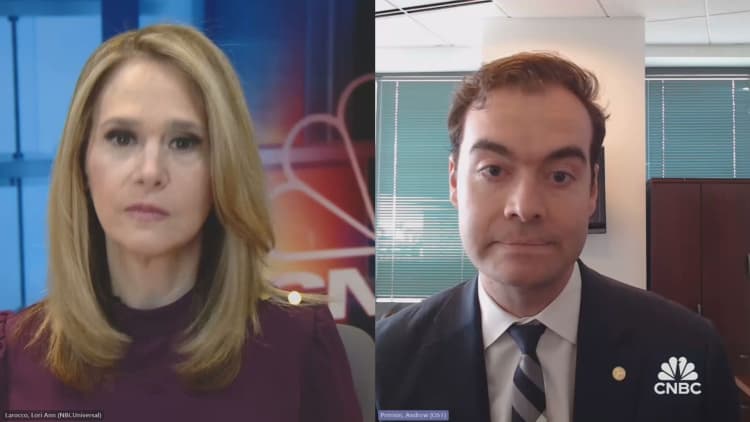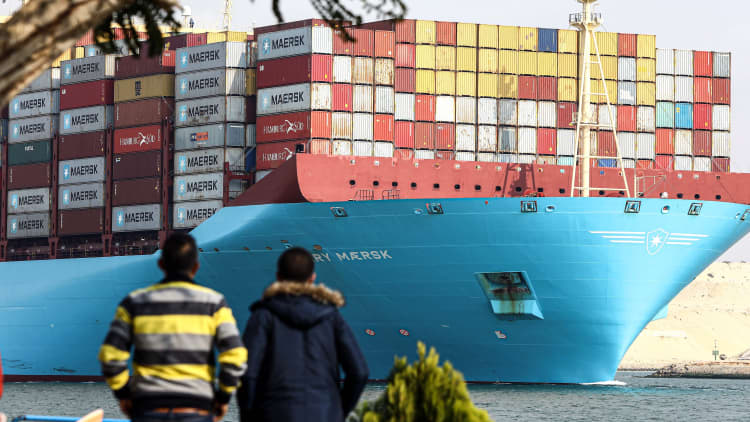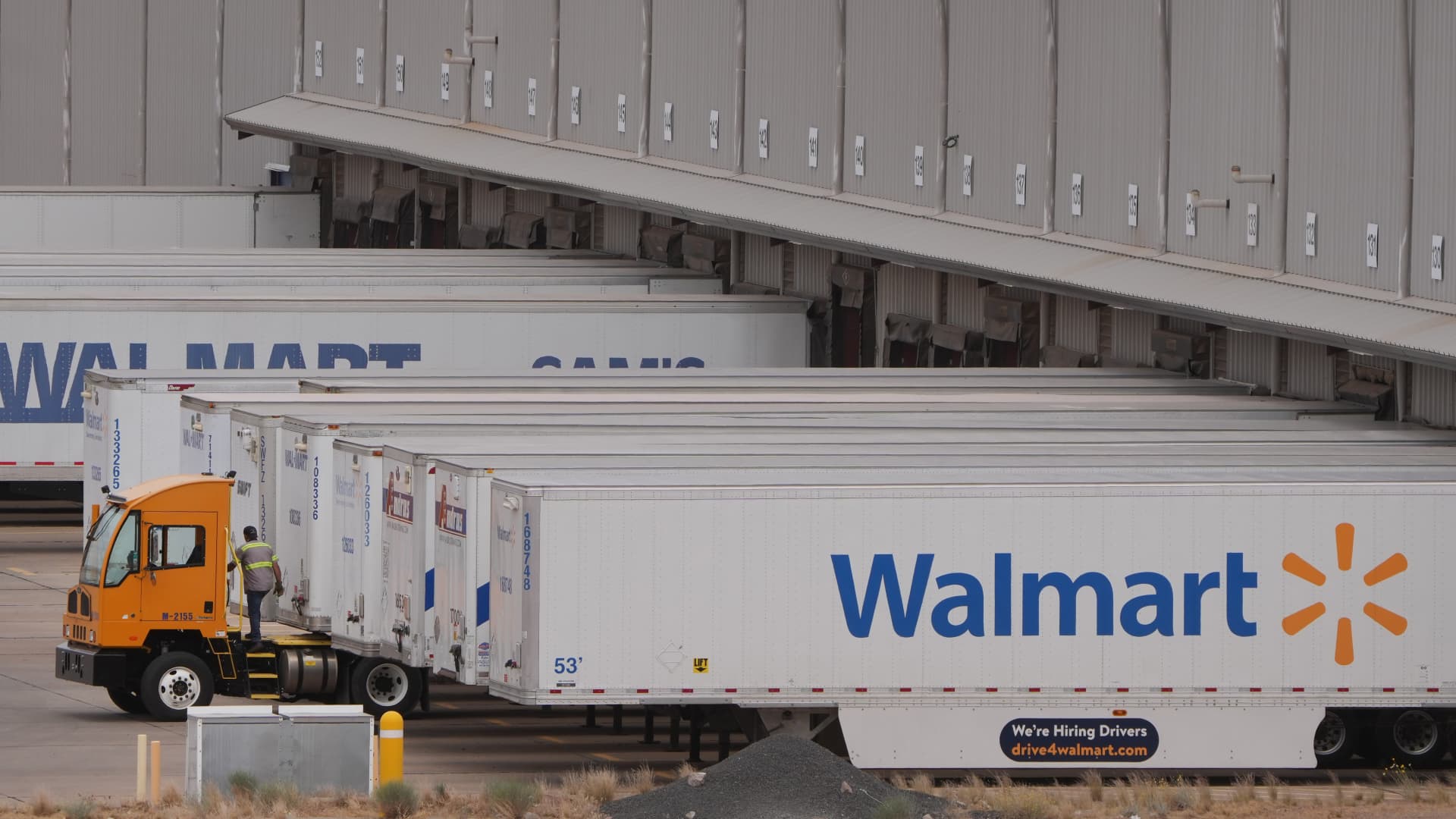
The Biden administration is expanding a freight data partnership with major U.S. companies to track the movement of goods in real time.
On Wednesday, the Department of Transportation is announcing that its digital platform for supply chain monitoring, Freight Logistics Optimizations Works (FLOW), is being expanded to capture and publish data on inland freight ports, including rail terminal and warehouse end-destination data.
Launched two years ago by the Biden administration, FLOW has partnered with retailers including Home Depot, Nike, Walmart, and Target; railroads Union Pacific and BNSF; and logistics providers CH Robinson, DHL, and FedEx. The platform has enabled participants to have a real-time snapshot of port and inland network congestion and monitor unexpected cargo shifts caused by world events, such as the Houthi attacks in the Red Sea.
A recent White House economic analysis found that more than 80% of recent progress in lowering inflation (disinflation) in the U.S. economy can be attributed to the supply chain.
“We are getting a look at actual demand,” said Andrew Petrisin, advisor for multimodal freight for the Department of Transportation, in an exclusive interview with CNBC. “By aggregating purchase orders from our shippers 40 days out and importer partners, as well as booking information from our ocean carrier partners 60 days out on a daily basis, the broader membership, can see and understand aggregate future demand.”
Petrisin tells CNBC the additional data will add to the knowledge that major firms gain from the platform, tracking container import volumes and traffic from the point of export origin into a U.S. port and eventually picked up by truck or rail and delivered to a warehouse or another inland port. The inland ports are critical to the flow of trade, from the pickup and drop off of loaded containers to the movement of empty containers so they can be loaded onto vessels to be filled again by foreign manufacturers.
Trailers are moved around at a Walmart Distribution center on May 19, 2022 in St George, Utah.
George Frey | Getty Images News | Getty Images
The FLOW platform connects the various supply chain pipes of partners to create an end-to-end, real-time snapshot of container traffic. Key information shared by the participants includes inbound containerized freight, starting with importer purchase orders, which is a barometer of future demand volumes against current regional capacity to move ocean containers.
The data is helping logistics decision-makers to manage and mitigate trade uncertainties, such as the recent Red Sea diversions and Panama Canal drought.
“It’s a collaboration tool,” Petrisin said.
Petrisin said ocean carriers are among partners that can use the data to plan ahead and make sure they have chassis available to load containers onto ships at the West Coast Ports. “We can get ahead of this and be proactive,” he said.
The overall goal of the data-sharing platform is to create a line of sight across the various trade routes and methods so participants can make the most informed decision, Petrisin said. As an example, “We’re working with an ocean carrier partner to use the purchase order data, to help make a better estimate on future bookings inland,” he added.
The DOT has held regular listening sessions with the freight industry and marine labor groups since the Houthi attacks in the Red Sea began last year. It is working with FLOW participants to leverage data on shift in cargo from the Suez Canal to going around the Cape of Good Hope in Africa.
Department of Transportation Secretary Pete Buttigieg has met with mariners, ocean carriers, ports, and other industry leaders to discuss the ongoing situation in the Red Sea and its impact on shipping and the freedom of navigation. Earlier this year, Deputy Secretary Polly Trottenberg traveled to the Panama Canal amid a drought that has reduced the number of vessels transiting the canal and has had an impact on international commerce.
“The Biden-Harris administration’s efforts to strengthen American supply chains have helped reduce inflation from pandemic peaks, and today, with the expansion of FLOW, we expect to see even greater benefits to American families and businesses,” Buttigieg said in a statement.
The White House and freight transportation
FLOW was created as part of the Biden administration’s response to four-decade high inflation and President Biden’s whole-of-government approach to supply chain disruptions brought on by the Covid-19 pandemic. The partnership started with a handful of participants and has expanded to over 70, with 60 additional participants in the process of being onboarded. According to Petrisin, the total volume of cargo volume being captured by FLOW at some major U.S. ports is nearly 80% as it is booked.
“If there’s a silver lining from the Covid pandemic, it’s that enhanced communication between each piece of the supply chain is critical,” said Jim Bishop, director of marketing and sales for Union Pacific, one of the first participants in FLOW.
Paul Brashier, vice president of drayage and intermodal at ITS Logistics, which is a FLOW partner, and whose ContainerAI was folded into the platform tells CNBC, “For the first time we are seeing a strategic executive branch effort to accumulate data and milestones and use that to identify and get ahead of supply chain bottlenecks before they metastasize,” Brashier said.
According to Jason Craig, director of government affairs for CH Robinson — which was one of the first companies to share its dataset on shipments, routings and carriers — said FLOW is the first time that a U.S. government office is advocating for freight transportation.
“Now there’s an office monitoring for disruptions and dedicated to working with all those other agencies to keep supply chains moving,” Craig said. “That’s the main reason C.H. Robinson was one of the first members of the FLOW initiative. … no other entity aggregates real, forward-looking supply chain data across the industry. The pandemic exposed that gap pretty painfully.”
Petrisin said the key to FLOW’s success is the real-time understanding of how demand is changing capacity and impacting the supply chain system. Reviewing the freight data in real-time helps retailers and logistics companies see the throughput of their cargo which can help them mitigate congestion and reduce logistics costs.
“Everything is interdependent,” Petrisin said. “Like terminal utilization and chassis availability. Providing aggregate statistics and information like this to the industry only complements their existing data and analysis to do better forecasting and service planning.”
The nation’s busiest container ports, including Los Angeles, Long Beach and New York, are part of the FLOW platform, as are top ocean carriers including MSC, Maersk, CMA CGM, and Hapag-Lloyd.

“We’ve been working closely with DOT Secretary Buttigieg and his team to improve the efficiency and timeliness of America’s supply chain through data sharing and data analysis,” said Peter Levesque, CMA CGM North America president and CEO. “The FLOW initiative is a good example of what’s possible when government and industry work together to solve the big issues that impact the U.S. supply chain.”
“We continue to see incredible benefits of this collaboration both in understanding what has happened in the past and in preparing for future disruptions,” said Goetz Alebrand, head of ocean freight Americas at DHL Global Forwarding.
For now, the data platform has been limited to use by active partners rather than shared widely with financial firms or the Federal Reserve for economic and markets analysis.
“We have received continued interest, obviously from a research standpoint and economic research standpoint,” Petrisin said. “We are still working through the proper processes and on what research usage might look like for this information, and that obviously has to come in communication with our members, and with the industry partners, because it’s their data.”
David Vaisberg, managing director of data science with industrial real estate investment firm Elion Partners, and a member of FLOW, said the port volume data provides it with improved ability to forecast logistics real estate demand.
“We get a real-time view of not only what has happened recently but also some expectations about what will happen in the next few months,” said Vaisberg. “The capability to see the next destination of goods flowing through the port gives us unprecedented insight into the U.S. supply chain and how it evolves.”
FLOW is among a number of DOT supply chain initiatives created through President Biden’s infrastructure law. The U.S. Maritime Administration announced in March an initiative to strengthen coastal and inland waterway ports with $450 million from the infrastructure funding. In January, DOT announced nearly $5 billion in grants to build or repair infrastructure projects geared toward relieving trucking bottlenecks and improving the movement of freight on the nation’s highways.
“This isn’t a one-month or two-month endeavor,” Petrisin said. He added that for both the DOT and its market partners, “FLOW is a long-term investment in digital infrastructure.”
“When the freight market tightens again, as it inevitably will, we hope FLOW will help avoid future bottlenecks and disruptions,” CH Robinson’s Craig said.

